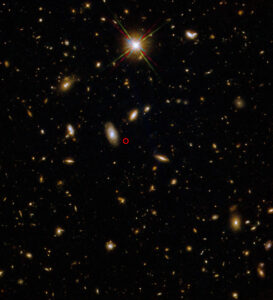First large-scale numerical simulation of black hole-neutron star merger matches puzzling observations
Last year, Northwestern University researchers uncovered new observational evidence that long gamma-ray bursts (GRBs) can result from the merger of a neutron star with another compact object (either another neutron star or black hole) — a finding that was previously believed to be impossible.
Now, another Northwestern team offers a potential explanation for what generated the unprecedented and incredibly luminous burst of light.
After developing the first numerical simulation that follows the jet evolution in a black hole-neutron star merger out to large distances, the astrophysicists discovered that the post-merger black hole can launch jets of material from the swallowed neutron star.

GRB 211211A’s location, circled in red, captured using three filters on Hubble’s Wide Field Camera 3. Credit NASA, ESA, Rastinejad et al. (2022)
But the key ingredients are the mass of the violent whirlpool of gas (or accretion disk) surrounding the black hole and strength of the disk’s magnetic field. In massive disks, when the magnetic field is strong, the black hole launches a short-duration jet that is much brighter than anything ever seen in observations. When the massive disk has a weaker magnetic field, however, the black hole launches a jet with the same luminosity and long duration as the mysterious GRB (dubbed GRB211211A) spotted in 2021 and reported in 2022.
Not only does the new discovery help explain the origins of long GRBs, it also gives insight into the nature and physics of black holes, their magnetic fields and accretion disks.
The study will be published today (Aug. 31) in the Astrophysical Journal.
“So far, no one else has developed any numerical works or simulations that consistently follow a jet from the compact-object merger to the formation of the jet and its large-scale evolution,” said Northwestern’s Ore Gottlieb, who co-led the work. “The motivation for our work was to do this for the first time. And what we found just so happened to match observations of GRB211211A.”
“Neutron-star mergers are a captivating multi-messenger phenomena, which result in both gravitational and electromagnetic waves,” said Northwestern’s Danat Issa, who co-led the work with Gottlieb. “However, simulating these events poses a challenge due to the vast spatial and temporal scale separations involved as well as the diverse physics operating across these scales. For the first time, we have succeeded in comprehensively modeling the entire sequence of the neutron star merger process.”
During the research, Gottlieb was a CIERA Fellow at Northwestern’s Center for Interdisciplinary Exploration and Research in Astrophysics (CIERA); now he is a Flatiron Research Fellow at the Flatiron Institute’s Center for Computational Astrophysics. Issa is a graduate student in the Department of Physics and Astronomy at Northwestern’s Weinberg College of Arts and Sciences and member of CIERA. Issa is advised by paper co-author Alexander Tchekhovskoy, an associate professor of physics and astronomy at Weinberg and member of CIERA.
Continue to the full Northwestern News story.

